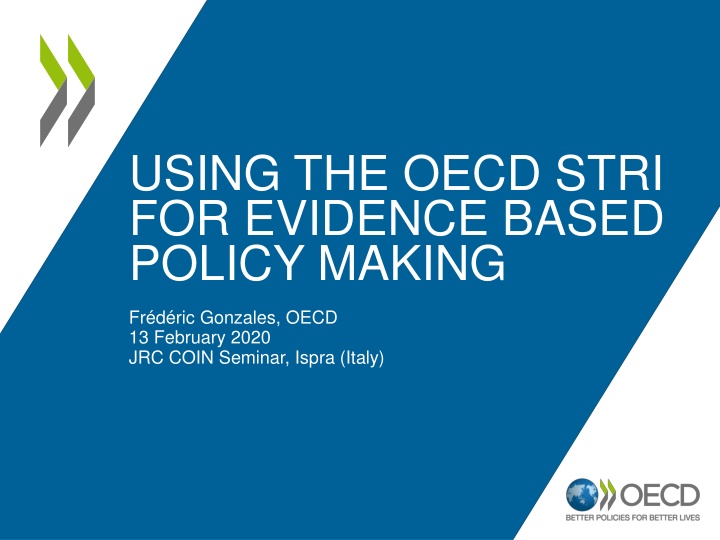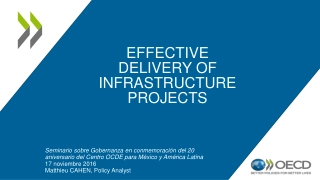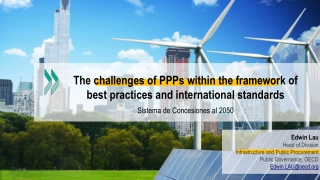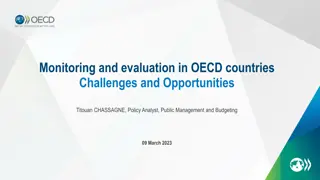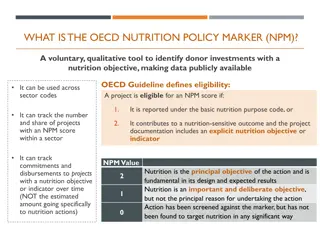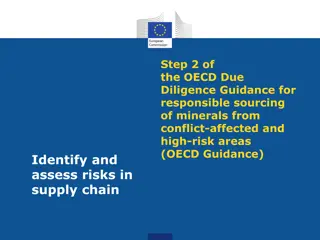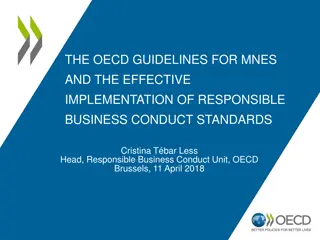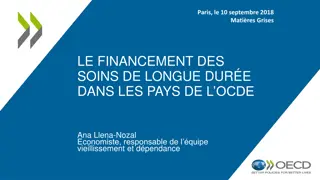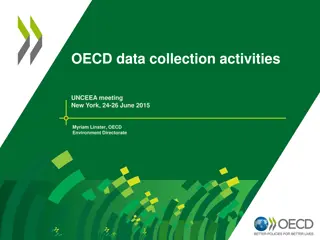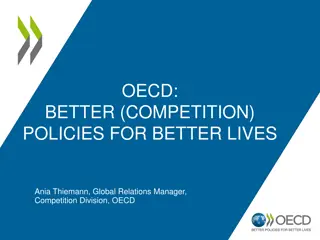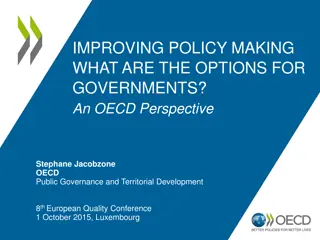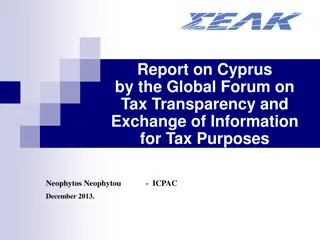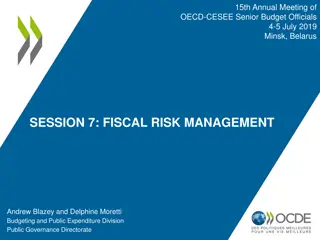Using OECD STRI for Policy Insights
The OECD STRI database offers key insights into trade in services, helping policymakers understand drivers and barriers. With components like regulatory database and composite indices, it provides a comprehensive view across various sectors.
Uploaded on Mar 04, 2025 | 0 Views
Download Presentation

Please find below an Image/Link to download the presentation.
The content on the website is provided AS IS for your information and personal use only. It may not be sold, licensed, or shared on other websites without obtaining consent from the author.If you encounter any issues during the download, it is possible that the publisher has removed the file from their server.
You are allowed to download the files provided on this website for personal or commercial use, subject to the condition that they are used lawfully. All files are the property of their respective owners.
The content on the website is provided AS IS for your information and personal use only. It may not be sold, licensed, or shared on other websites without obtaining consent from the author.
E N D
Presentation Transcript
USING THE OECD STRI FOR EVIDENCE BASED POLICY MAKING Fr d ric Gonzales, OECD 13 February 2020 JRC COIN Seminar, Ispra (Italy)
Services are important and tradable Services are important High income Low income Middle income 80% 70% 60% Servies (% of GDP) 50% 40% 30% 20% 10% 0% 2005 2006 2007 2008 2009 2010 2011 2012 2013 2014 2015 2016 2017 Source: World Bank, WDI Services are tradable The internet Lower cost of travel But what drives trade in services? And what hinders it?
Why the STRI? Services share of: To better understand what drives and hinders trade in services Employment GDP To provide trade negotiators with comparable information on current policy FDI inflows VA exports A tool for trade policy analysis Gross exports 0% 20% 40% 60% 80% 100%
STRI: two components 1. Regulatory database: Database of services trade restrictions Standardised set of measures, with links to sources - more than 11000 laws and regulations 2. Composite indices: Transforming the qualitative information into quantitative data Take values between 0 (open) and 1 (closed) Coverage: 46 economies and 22 services sectors
STRI sectoral coverage (22) Trade and Finance Support Digital Network Physical Infrastructure Supply Chain Air transport Computer Legal Maritime transport Architecture Rail transport Telecoms Road freight transport Accounting / auditing Cargo handling Broadcasting Engineering Customs brokerage Commercial banking Freight forwarding Motion pictures Storage & warehousing Construction Distribution Insurance Sound recording Postal and courier 5
STRI REGULATORY DATABASE
Main elements of the database Answer Mostly just a simple yes or no Numerical answers (e.g., foreign equity) na for non-applicable very limited cases Source Official legal instrument or sector regulation Common elements Title in English; title in original language; details about legal instrument; link to official source Comment Short, relevant for the measure,if needed to clarify the answer
5 Policy areas of the STRI database Example of measures Restrictions on foreign entry 1.1.x. Equity restrictions 1.2.x Restrictions on legal form 1.4.x Board of directors and managers 1.5.x FDI screening 1.7.x - 1.10.x Other investment barriers 1.12.x Performance requirements 1.16.x Commercial/local presence requirement 1.20.x Cross-border data flows Restrictions to movement of people 2.1.x Quotas 2.2.x Labour market tests 2.3.x Duration of stay 2.4.x - 2.5.x Nationality/residency for professional license 2.6.x - 2.8.x Recognition of foreign qualifications Other discriminatory measures 3.1.x Taxes 3.2.x Public procurement 3.3.x Standards Barriers to competition 4.1.x - 4.2.x Appeal and redress 4.5.x Fee-setting 4.6.x Capital requirements 4.7.x Advertising Regulatory transparency 5.1.x - 5.2.x Communication of legislative process 5.3.x Business visa restrictions 5.4.x - 5.6.x Doing business
Services regulatory measures Policy area Measure Answer Source Comment Restrictions to foreign entry Foreign equity limit 49% Foreign investment law, Article Restrictions to movement of people Labour market test Yes Immigration Act, Article Applies to non-EU citizens Other discriminatory measures Discrimination in taxes and subsidies Yes Decree on R&D Foreign firms not eligible for R&D subsidies Barriers to competition Interconnection is mandated Yes Telecoms law, Article Applies to dominant operators Regulatory transparency Transparent licensing conditions Yes Circular by sector regulator Criteria available on the regulator s website 9
The STRI is a composite index Uses information on de jure regulation only A snapshot of trade restrictiveness for the countries and sectors included at a particular point in time Gives the broad picture whereas fine details covered in the database Changes in the index over time is as useful as capturing restrictiveness levels in the first year
Scoring Assigning numbers to qualitative information Binary scores (0 and 1) Refinements: Break complex or continuous measures into several thresholds Construct nested layers/hierarchies of measures Different market structure and regulatory regimes Construct regulatory packages when measures are complementary 12
Example of thresholds: Foreign equity limits Thresholds No foreign equity Less than a third Less than half Less than 100% Score if max is 49% Score if max is 65% 0 0 1 1 0 0 0 1
Example of hierarchy Foreign equity 0% 49% 100% Board members Screening M&A scored 1 All measures related to FDI scored 1 All measures scored normally
Example of different regulatory regimes Barriers to competition Dominant supplier Competitive markets Price regulation is bad Regulation is good
Weighting Equal weighting of all measures within policy categories Weights of the 5 policy areas assigned by expert judgement Online survey experts asked to allocate 100 points among the five policy areas Large number of experts per sector from a diverse set of countries: 380 experts, 50 countries, on average 20 experts per sector (from 15 in transport to 50 in telecom and auditing) 16
Contribution by measure ??? = ???????? ????? Where: scorej is a binary score (0,1) of measure j depending on whether the measure is open (0) or restrictive (1) ?? is the number of measures under category i ?? is the share of the total number of points allocated to policy area i by the experts
Experts weights by policy area Computer Accounting/auditing Telecom Air transport Banking Experts/Country coverage 29/18 52/24 NM 48 29 6 7 10 100 48/24 15/13 31/14 EW 17 21 18 20 24 100 NM 28 14 5 8 10 65 AW 39 23 7 13 19 100 EW 25 22 16 17 20 100 AW 53 29 4 5 9 100 EW 28 13 15 23 20 100 NM 39 14 9 43 12 117 AW 41 7 5 38 9 100 EW 25 14 24 20 18 100 NM 79 13 9 45 14 160 AW 56 5 6 26 7 100 EW 26 12 19 21 22 100 NM 39 13 14 20 15 101 AW 47 7 12 19 15 100 Restrictions on foreign entry Restrictions to movement of people Other discriminatory measures Barriers to competition Regulatory transparency Total
Sensibility analysis: Digital STRI example (1) Equal weights 1 0.9 0.8 0.7 0.6 0.5 0.4 0.3 0.2 0.1 0 The Spearman rank correlation between expert judgment and equal weights is 0.97
Sensitivity analysis: Digital STRI example (2) 1 1 0.9 0.9 0.8 0.8 0.7 0.7 0.6 0.6 0.5 0.5 0.4 0.4 0.3 0.3 0.2 0.2 0.1 0.1 0 0 POL CAN FRA ITA LTU NZL JPN MEX IND NLD USA BRA DNK IRL HUN AUS DEU EST FIN GRC KOR SVK AUT BEL COL CRI ESP ISL LUX LVA ISR SVN TUR CHL CZE CHE CHN NOR SWE ZAF GBR IDN PRT RUS stri Upper limit Lower limit Mean for random weights
Sector profiles 1 0.9 0.8 0.7 0.6 0.5 minimum 0.4 maximum average 0.3 0.2 0.1 0
Sector example: computer services (2019) 1 0.9 0.8 0.7 0.6 0.5 0.4 0.3 0.2 0.1 0 CAN FRA LTU IRL CRI LVA LUX HUN TUR THA FIN MYS IDN CZE SVK SVN USA ESP ZAF EST NOR CHN CHE IND KOR DNK BEL CHL AUS GBR GRC AUT RUS JPN ITA BRA DEU NLD NZL COL POL ISR ISL SWE MEX PRT Restrictions on foreign entry Restrictions to the movement of people Other discriminatory measures Barriers to competition Regulatory transparency Average STRI 2014
Top performers in 2019 25 NLD 20 LTU LVA NUMBER OF TOP 10 RANKINGS ACROSS ALL SECTORS CZE 15 FRA PRT IRL JPN CAN DNK 10 AUS DEU KOR CHL LUX GBR SVK ESP USA COL 5 EST SWE CRI MEX NZL SVN ISL MYS GRC IDN IND ISR ITA RUS NOR TUR AUT FIN BRA 35 0 THA POL HUN 0 5 10 15 20 25 30 40 45 CHN BEL CHE -5 AVERAGE RANKING
Country profile: Thailand (2019) Restrictions on foreign entry Restrictions to movement of people Other discriminatory measures Barriers to competition Regulatory transparency Average Minimum 1 0.9 0.8 0.7 0.6 0.5 0.4 0.3 0.2 0.1 0 Air transport Legal services Cargo-handling Customs brokerage Insurance Maritime transport Accounting services Construction Computer services Sound recording Distribution services Broadcasting Road freight transport Rail freight transport Freight-forwarding Courier services Architecture services Commercial banking Storage and warehouse Telecommunication Motion pictures Engineering services Digital network Transport and distribution supply chain Market bridging and supporting services Physical infrastructure services
Changes in scores (2018-2019) Cumulative trade liberalisations (2018 to 2019) Cumulative trade restrictions (2018 to 2019) 0.14 0.12 0.1 0.08 0.06 0.04 0.02 0 -0.02 -0.04 -0.06 Legal services Motion pictures Architecture services Custom brokerage Courier services Cargo-handling Insurance Sound recording Computer services Road freight transport Freight forwarding Air transport Engineering services Storage and warehousing Construction Distribution services Maritime transport Rail freight transport Commercial banking Broadcasting Accounting services Telecommunications Digital network Transport and distribution supply chain Market bridging and supporting services Physical infrastructure services
Regulatory heterogeneity for digitally- enabled services in G20 countries (2018)
2019 Services policy trends Barriers to services trade are rising: New OECD data demonstrates an accelerated shift towards increasing trade restrictive measures across most services sectors. New restrictions have economy-wide implications ; affecting foreign investment, conditions related to commercial establishment, and the temporary movement of services providers. Digital trade is confronted by growing restrictions: New analysis reveals an increasing level of restrictiveness affecting trade in digitally enabled services in 2019. The European Economic Area (EEA) market for services continues to liberalise: Liberalisation through EU/EEA and domestic reforms of EU Member States affected the logistics of cargo-handling services, and commercial banking and insurance services.
What can it be used for? Identify domestic reforms Identify regulatory bottlenecks and regulatory spillovers across sectors and policies Analyse how regulation shapes global value chains e.g. which activities are located in which economies Estimate ex ante the likely impact of reforms on industrial structure, employment, relative wages and welfare Support regulatory cooperation across economies
Thank you !! Contact us We look forward to your comments! You can reach us via e-mail by sending your message to the following address: We invite you to connect with us on Twitter by following: Access all of the information from the Trade & Agriculture Directorate at: tad.contact@oecd.org @OECDtrade www.oecd.org/tad
